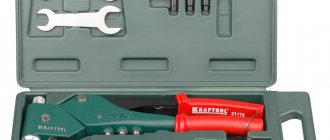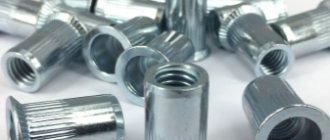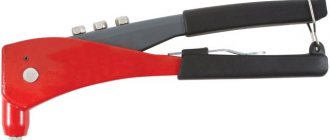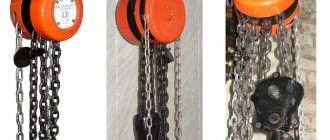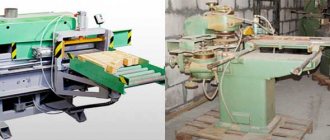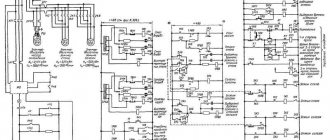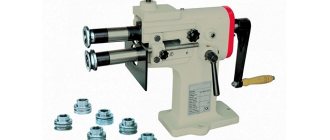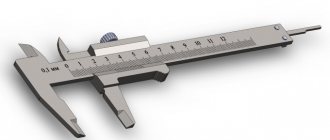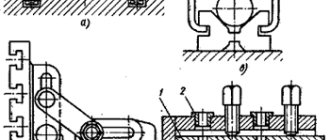What is a manual riveter
Riveters are these types of hand tools that are used to connect two metal workpieces up to 10 mm thick. The main purpose of the tool is to provide a permanent connection of sheet metal. The connection of metal sheets occurs through the through-mounting method. This tool is used when it is impossible to use welding and threaded connectors. Structurally, the tool has the shape of pliers and consists of the following components:
- Handle - sets the mechanism in motion by applying physical force of a person
- Clamping mechanism, which comes in two types - pull-out and threaded
- Head - the fixing part on which the consumable element is attached
This is a simple device that allows you to quickly and permanently connect sheet metal. Riveters are not only manual, but also pneumatic, electric and battery-powered, but the first type of tool is more popular. This is due to a number of advantages, the main ones being affordable price, ease of use and no need to use additional equipment.
Pneumatic, electric and battery-powered devices are more expensive and are intended to be operated by specialists. The main advantage of pneumatic, electric and battery-powered devices is that they do all the work, so the operator does not need to exert any effort. The relevance of their use arises in the case of using large diameter rivets.
This is interesting!
Manual riveters are also called riveters. They come in two types, and to find out what differences they have, let’s look at their parameters.
Threaded riveter or nut riveter - its pros and cons
This is a special type of riveter, which is designed to work with threaded rivets. This type of tool provides a more reliable connection, and also allows it to be further strengthened through the use of bolts. The threaded connection ends up being permanent. The hole after the connection has an internal thread. The operating principle of threaded riveters is based on the fact that a threaded rivet is screwed onto the tool head (rod or threaded part). After this, a rivet attached to the tool is inserted into the hole, and the handles are compressed. When the handles are compressed, creasing or flaring occurs on the opposite side of the riveting, resulting in the formation of a head.
The design of the threaded riveter is shown in the photo. This type of tool is classified as powerful, and therefore the larger the size of the rivet, the more effort the operator must exert to make the connection. The advantages of such devices include high quality connections, which can be strengthened with a bolted element. In addition, the advantage is the ability to use rivets of different sizes, which also affects the quality of the connection. Such instruments have more disadvantages, and they manifest themselves due to the following factors:
- High cost of the tool: more than 2,500 thousand rubles
- The need to apply great physical effort, which increases depending on the diameter of the riveting
- Low connection speed, since the rivet must first be screwed onto the threaded tip of the tool, and after connection, the device must be unscrewed
- The high cost of not only the tool, but also the rivets
It is rational to choose a threaded riveter only when it is necessary to ensure a reliable connection of sheet steel, as well as in the presence of large diameter holes. The presence of holes at the joints allows the resulting structure to be fastened.
Types of riveters
The classification of riveters is quite extensive, and it depends on the design features of the tool.
There are 18 main types of rivet tools: By type of drive:
- mechanical;
- pneumatic;
- electric;
- battery;
- pneumohydraulic.
By type of rivets used:
- exhaust (traction);
- threaded;
- universal.
Depending on the location of the working head in relation to the body:
- straight type;
- corner type;
- double-sided;
- two-position;
- turning.
Depending on the handle design:
- one-handed;
- two-handed;
- rocker (accordion type).
By functions performed:
- riveter;
- rivet adapter.
Let's look at the characteristics and features of each type of riveter in more detail.
Mechanical
A mechanical or manual riveter is the simplest tool in design. To connect materials with its help, physical effort is required to compress the handles.
Mechanical devices have a low price. Therefore, they are used both for professional work and at home.
Pneumatic
Pneumatic riveters use the energy of compressed air coming from a compressor for their work. They are powerful and do not require any physical effort during operation. However, pneumatic models are much more expensive than mechanical ones.
Electric
An electric riveter is a corded tool that converts electrical energy into compressive force. To fasten materials, simply place the tool in the correct position and press the button.
The tool operates from a network with a standard voltage of 220 V. Thanks to this, the device can be used for household construction and repair work. When purchasing, it is important to pay attention to the length of the power cable, since it will determine how far the user can move from the outlet.
Electric models are much more expensive than mechanical and pneumatic ones, but their performance is much higher.
Rechargeable
Battery models are a type of electric riveters that use a battery rather than an electrical network for power. Thanks to the battery, they are more portable and do not require constant power from the mains. But due to the additional design element, battery riveters weigh more than electric ones.
The prices for such models are high, and the larger the battery capacity, the more expensive the tool will be.
Pneumohydraulic
A pneumohydraulic riveter is an industrial type of tool with a compressor that allows the use of large threaded rivets. Such equipment is distinguished by reliable fastening of parts, which is achieved due to the formation of high clamping force.
Such models have a very high price, so they are used only for professional work, mainly in the engineering industry.
Exhaust (traction)
The pull-out riveter has a principle of operation similar to threaded models. But instead of threads, the exhaust device uses a metal pin, which is part of the rivet. The pin is placed in the hole of the tool and then inserted into the hole drilled in the sheet material. When the handles are compressed, the rivet is crushed on the reverse side, which leads to the pin being pulled outward. This mechanism allows the rivet to completely close the hole in the materials being joined.
The blind riveter has a very simple design, is easy to use and is capable of making beautiful hidden connections. However, they cannot join materials with a maximum hole diameter greater than 7 mm.
Threaded
The thread riveter is used for highly reliable connection of materials using threaded rivets. To fasten the elements, a rivet is screwed onto a threaded rod and inserted into the hole. Afterwards, under the influence of strong compression of the handles, the riveting is crushed on the back side of the tool, a head is formed, and the materials are firmly pressed against each other.
The price of threaded riveters is high, as are the consumables for its operation.
Universal
Universal models are suitable for working with blind and threaded rivets. For this purpose, the riveter is equipped with suitable interchangeable heads.
Straight type
Direct type riveters, or end riveters, are equipped with a head in the end part of the tool, which is fixedly directed along the tool body.
Corner type
In angle-type riveters, the head is fixed at a right angle to the body.
Double sided
A double-sided riveter is a type of corner riveter in which the head has a removable design and can be moved to the rear of the body.
On-off
A special feature of the two-position (adjustable) riveter is that its head can be installed at an angle of 90° or 180° relative to the body.
Turning
The rotary riveter is equipped with a special hinge mechanism, thanks to which the head can be rotated 360° in relation to the body. This mechanism is convenient if rivets will be installed in hard-to-reach places.
Exhaust view of the riveter - what is it?
This is a tool whose operating principle is similar to threaded ones, only instead of a threaded rod tip, a cylindrical pin is used. These studs are mounted on rivets. The rivet is inserted into the tool hole and then positioned into the pre-drilled hole in the sheet stock. Impact on the tool handles leads to crushing of the rivet on the reverse side by pulling the pin outward. The pin is pulled out and a riveted joint is obtained.
The advantages of exhaust riveters include:
- Low cost, unlike threaded ones
- High speed of work completion
- Easy to install
- It turns out a secret connection
The only disadvantage can be considered that in this way it is impossible to connect sheet steel in which large-diameter holes are made. Such tools are intended for joining sheet metal with hole diameters up to 7 mm.
Types of tools by number of handles: one-handed and two-handed
In addition to the fact that riveters come in threaded and pull-out types, they also differ in the number of handles - one-handed and two-handed. A one-handed riveter is considered to be a tool in which one handle is movable and the other is fixed.
These are often exhaust devices that do not require much effort. They are designed for connecting rivets with a diameter of up to 6.4 mm.
Two-handed riveters are devices in which both handles are movable.
These are often threaded-type models, which require a lot of physical effort. They allow for riveted connections using rivets with a diameter of up to 14 mm.
Accordion riveters are a special type of tool that consists of one handle connected to a pressing mechanism in the form of an accordion or toad.
Such a tool also belongs to the category of traction tools, and the design cannot provide high clamping force. Accordion riveters are more expensive than conventional one-handed riveters.
All versions of hand tools are additionally equipped with swivel heads (except for the accordion), which allows riveting connections even in the most difficult to reach places.
The head of such tools has the function of moving up to 360 degrees, which greatly facilitates the use of the tool. However, the cost of such a device is 1.5-2 times higher than a conventional one with a fixed head. For home use, riveters with rotary heads are not needed, so it is not worth spending a lot of money just to have a multi-tool.
This is interesting!
Rotary rivet heads are used by specialists whose work involves the installation of sheet metal, as well as in the manufacture of structures, for example, mailboxes, etc.
Types of manual (mechanical) riveters
There are three types of manual rivet setters:
- one-handed;
- two-handed;
- harmonic.
One-handed ones are designed for small fasteners - up to 5 mm. They differ in that their working handles are at an angle of 90° to the installation axis. That is, the handles are pointing down. It is convenient because you can work with one hand. The disadvantage is the small “range” of sizes that the device can work with.
Two-handed ones are large in size; they can also install rivets of large diameters - up to 8 mm. You can distinguish them by their appearance - long handles that are in the same plane as the working jaws. It makes sense to choose a two-handed riveter if you plan to use large diameter rivets.
Types of manual riveters: one-handed, two-handed, accordion
Mechanical accordion riveters are often used with large-sized fasteners. The presence of that very “accordion” allows you to install large-sized fasteners with less effort. Such a device usually has a more expensive tool and is more often used by professionals.
Choosing the type of manual riveter is not too difficult. If you need a reliable machine, choose from two-handed models. Their design is simpler, there is almost nothing to break. At normal quality they are indestructible. If you will only install small fasteners - no more than 2-3 mm, then it is more advisable to use a one-handed one. It's more convenient for them to work.
What types of rivets are available?
The riveting method does not lose popularity, even despite the availability of different welding equipment. Not all materials can be welded, so the use of rivets has been and will always be relevant. Depending on the tool used, rivets or also called bosses are classified into the following types:
- Ordinary or classic - this is the simplest type of rivets, which have the shape of a fungus.
Designed for riveting two or more sheets of steel without the use of specialized tools. The principle of operation of such rivets is that the connection is made by crushing the head of the boss with a hammer - Semi-tubular - they look like a half-hollow rod.
The advantage of such equipment is that they do not require much effort to connect, but they have low strength, which is their disadvantage. They are usually used where there are small mechanical loads - Exhaust - they are also called embedded, tear-off and traction.
They are used in conjunction with blind riveters, and are often used not only for joining galvanized sheets, but also when installing fences made of corrugated sheets - Piston - used to ensure the connection of two parts where there is little or no load.
Commonly used on clothing as a decorative material - Threaded - they are also called nuts.
They are also intended for use in conjunction with a specialized tool - a thread riveter. This is the most reliable type of riveted connector
All types of rivets are used in different fields - mechanical engineering, auto repair, construction, manufacturing of sheet steel structures, tinsmiths, etc. Depending on the type of riveter, it is necessary to select the appropriate bosses. If you need to make a one-time connection using the riveting method, you will not need to buy a special tool. For this, classic rivets are used.
When choosing, you need to take into account that rivets come in different diameters, which affects the quality of the connection. Tie rivets are available in the following sizes:
- 2.4 mm
- 3 mm
- 3.2 mm
- 4 mm
- 4.8 mm
- 5 mm
- 6 mm
- 6.4 mm
Threaded rivets are also available in different sizes:
- M3
- M4
- M6
- M8
- M10
- M12
- M14
The larger the size of the rivet, the higher its cost, and, accordingly, the stronger the connection.
This is interesting!
Materials used to make rivets include aluminum, stainless steel, brass, copper and even steel.
Rating of the best riveters
| Nomination | place | Name of product | price |
| Rating of the best riveters | 1 | HASKYY CRP-17 | 6 780 ₽ |
| 2 | Kraftool 31170-H6 | 829 ₽ | |
| 3 | BISON Station wagon 270mm | 1 899 ₽ | |
| 4 | STANLEY MR55 0-69-804 | 799 ₽ | |
| 5 | Armero A320/104 rotary | 1 231 ₽ | |
| 6 | BISON Master MX500 (31032) two-handed | 676 ₽ | |
| 7 | Cobalt 243-547 | 729 ₽ | |
| 8 | STAYER Supermax 3116 | 536 ₽ | |
| 9 | Sibrtech 40543 | 504 ₽ |
HASKYY CRP-17
Rating: 4.9
The lever riveter HASKYY CRP-17 was created for professional activities. The German tool is capable of working with a wide range of rivets. This can be a pull-out (blind) fastener or threaded type rivets (nut and screw). The device allows the use of fasteners with a diameter of 3.2-6.4 mm during assembly work. The manufacturer has equipped the tool with a set of attachments (18 pcs.) and a wrench for replacing them. For ease of storage and movement there is a plastic case. Experts appreciated the German quality and rich equipment, giving the riveter first place in our rating.
User reviews praise the tool for its high quality, ease of use, and easy replacement of equipment. The only disadvantage is the high price.
Advantages
- high-quality assembly;
- full set of attachments;
- can work with different rivets;
- convenient case.
Flaws
- high price.
Riveter operating principle of the tool
The operating principle of all types of devices is the same, but there are some differences. If you are using a manual riveter for the first time, it will be useful to learn about how it works.
The main operating principle of a manual riveter is based on the transmission of force from the lever mechanism to the head. To begin with, a consumable element is inserted into a pre-prepared hole. To ensure compression of the rivet, a compression mechanism is used, through which deformation occurs. As a result, the consumable element, due to the protrusions (skirts), ensures a reliable connection of the sheet material. How different types of riveters work, we will consider in detail below.
Top 5 best riveters for blind rivets
In construction, not only threaded, but also exhaust fasteners are often used. They are highly durable and at the same time quite easy to install. Hand tools from different price categories with a power or automatic operating principle allow you to quickly install rivets.
Metabo NP 18 LTX BL 5.0
The compact yet powerful riveter works with pull-out fasteners up to 5mm in diameter and is suitable for use in hard-to-reach areas. Equipped with a backlight and a belt clip, it is very convenient to use and does not cause rapid fatigue due to its low weight. The tool comes complete with a wrench for quick replacement of attachments.
Important! The cordless riveter is compatible with all Metabo 18 B batteries and has a charge indicator to indicate when the battery is low.
The average price of Metabo NP 18 is 47,000 rubles
Gross 40409
Two-handed reinforced riveter for pull-out fasteners up to 64 mm is designed for durable connections of sheet metal and steel profiles. Equipped with a collet mechanism for capturing pins, the working part is made of deformation and corrosion resistant chrome-molybdenum steel. The riveter provides a particularly tight grip on the fastener and puts little strain on your hands even during long-term use.
You can buy the tool complete with attachments for steel and aluminum pins of different sizes. The set also includes a key for quickly changing them.
You can buy a Gross riveter from 4,000 rubles
Milwaukee M12 BPRT-0
The cordless manual riveter works with fasteners up to 4.8 mm in diameter and is designed for steel, copper and aluminum rods. Supplied with several tips, it is equipped with LED backlighting, making it easier to work in limited and poorly lit spaces. The model has a battery charge indicator.
You can buy a manual riveter Milwaukee M12 from 21,000 rubles
Kraftool 31180
The manual riveter for pull pins has compact dimensions and a convenient lever mechanism. Among the advantages are the high strength of the tool, an ergonomic body and rubberized handles that prevent fingers from slipping during use. The model is suitable for any small-scale facade and repair work in a house or country house where high productivity is not required. Interacts with rivets made of aluminum and steel, guaranteeing strong, reliable and neat fastening of sheet materials and profiles.
The price of a manual riveter Kraftool 31180 is about 3,500 rubles
Kraftool 31170-H6
A very inexpensive power riveter suitable for repair work and reliable connection of sheet materials. It is reliable and simple, made of cast steel. The handles of the device are rubberized and equipped with finger restraints, so they do not slip in the palms and do not leave calluses on the operator. The kit includes replacement tips, spare connectors and a shipping container.
You can buy a manual riveter Kraftool 31170-H6 for only 800 rubles
Threaded riveter, principle of its operation, step-by-step instructions
The most reliable connection is ensured using threaded devices. The principle of their operation is quite simple, but it causes some inconvenience - each rivet must be screwed onto the end of the tool before use. The instructions on how threaded devices work are as follows:
- Initially, it is necessary to drill a hole of the appropriate diameter in sheet steel - from 3 to 14 mm or M3-M14
- Install a threaded tip (rod) into the tool head of the appropriate diameter.
- Screw the threaded boss onto the tip until it stops.
- Install the rivet into the holes of the elements to be connected
- Perform riveting by acting on the levers (bringing them together)
- Next, to disconnect the tool from the resulting connection, you will need to unscrew it
- After this, the connection is ready for use, and a bolt of the appropriate diameter can be screwed into it
For clarity, below is a video that shows what a threaded tool is and how it is used.
Riveter accordion toad principle of its use
The principle of operation of the accordion riveter is quite simple and uncomplicated. When using it, it is important to consider that there must be enough free space for riveting. The length of the tool in the extended position reaches 80 cm. The principle of using the tool is as follows:
- First you need to install the rivet into the device with the pin inward.
- Fully release the handle
- Install the rivet into the hole
- Compress the accordion-shaped mechanism
- Remove the remaining pin from the tool chuck
Detailed video description below.
The advantage of the toad is that the operator needs to exert less effort than when working with a tool that has one movable and fixed handle.
Selecting a blind riveter
Most often you have to work with blind (traction) rivets. They are convenient and inexpensive. The tools to install them don't cost too much either. In addition to the parameters listed above, in order to select a rivet tool for traction rivets, you also need to pay attention to some special characteristics and options.
- The number of clamping jaws (petals) in the collet. The tool grips the rod and pulls it to form the closing head. So, there can be two or three petals. Double-lobed ones are cheaper, but when grabbed, the rod can become skewed and get stuck. You have to take it apart and put it back together again. It’s inconvenient, and it takes time. There may be several forms.
- Presence of a ratchet . When working with strong rivets (steel), it is important to correctly calculate the force. A ratchet helps with this.
- Container for collecting broken rods . During operation, the excess rod breaks off. If there is no container, they often end up underfoot and then have to be collected. The presence of capacity solves the problem, but has almost no effect on the price.
Now you know how to choose a riveter for blind rivets. Having selected several models that suit you in terms of characteristics, inspect them and hold them in your hands. If possible, try it a couple of times at work. This will make it easier to understand which tool is more convenient for you to work with and it will be easier to make a choice.
How to use a regular riveter - rules and recommendations
If you have an ordinary model of a riveter, then the instructions for using it are identical to using an accordion tool. A rivet is installed in the hole of the tool, having previously selected the required cartridge (depending on the size of the stud). Afterwards, the boss fixed in the gun cartridge is compacted into the preliminary hole of two sheet materials. By acting on the handle, the wall of the boss is compressed by pulling out the inner pin with the tip. The wall on the reverse side is flattened, thereby making a reliable connection. If protruding parts of the boss remain, they can be removed with pliers.
A diagram of the operating principle of a manual riveter is shown in the photo below.
Experts recommend a clear approach to the choice of rivets. The effectiveness of the connection depends on their choice. If the length of the boss is less than the thickness of the workpieces to be joined, then in the end the connection will not work. The length of the boss itself should be 2 times the thickness of the parts being connected, but no more.
How to choose a quality device
Why does the question of how to choose a riveter remain relevant? After all, despite the fact that the tool belongs to the manual category, it has a fairly high cost. To save money, many buyers decide to take a desperate step - they choose cheap models. As a result, the device fails very quickly, and it turns out that the money was wasted. You should also not buy expensive models, since it turns out that the tool will simply lie on a shelf in the garage most of the time. What to consider when choosing a manual riveter - there are the following nuances:
- Device body material - do not buy plastic models.
No matter how colorfully manufacturers and sellers describe them, such instruments are toys that are only suitable for children. You need to choose devices only from high-quality steel. Reputable manufacturers indicate the type of steel used in the technical description - How much does the tool weigh? A good thread riveter has an appropriate weight, which allows it to be used for connecting rivets with a diameter of 12-14 mm
- Equipment - usually good and high-quality devices are sold complete with replaceable heads, as well as consumables.
In addition, the devices are located in special plastic, metal or wooden cases, which simplifies not only their storage, but also transportation - The manufacturer is very important, since today different manufacturers with unknown reputations appear on the market.
It is not recommended to tempt fate, so choose riveters from manufacturers such as Kraftool, Matrix, Gross, JTC, Stayer and others
This is interesting!
If you plan to use the tool frequently, then preference should be given to reinforced riveters.
They are more expensive than regular ones, but last longer and are designed specifically for long-term use. Drawing a conclusion about what types of manual riveters there are, it must be said that tie-type models are quite sufficient for home use. A threaded tool can also come in handy, but only if you plan to work with sheet steel. Proper storage and use will increase the service life of even a budget tool model.
How to choose a riveter
Purpose.
The starting point when choosing a riveter will be the purpose of the tool.
- If a model is required for professional activities, then a multifunctional device is selected that is capable of working with a wide range of rivets. For intensive use, it is better to give preference to models that have adjustable compression force.
- For home use, budget devices that can work with popular types of rivets are suitable. 3-4 nozzles and a wrench will be enough to select the appropriate fasteners for assembly.
Design.
On sale you can find two options for making rivets.
- One-handed designs are compact in size and easy to work in hard-to-reach places. But the user will have to apply a fairly high compression force, which causes the hand to quickly tire.
- The two-handed tool is capable of solving the most complex tasks. It creates a lot of pressure, so there are no restrictions on the diameter and material of the rivets. Only with long handles it is not possible to work everywhere.
Working mechanism
. Different riveters use a stationary or mobile working mechanism.
- When difficulties arise due to limited space, the rotary operating mechanism comes to the rescue. In such a tool, you can rotate the head to any angle.
- Some manufacturers provide the option of rearranging the mechanism. In this case, the user selects one of two positions (0 or 90 degree angle).
- When you have to rivet parts of the same type in a convenient position, you can give preference to simpler and more reliable irrevocable mechanisms.
Equipment.
The price of a riveter is influenced not only by the brand name, build quality, functionality, but also by the richness of the equipment. In addition to the tool, the manufacturer usually provides replacement attachments. But the key for replacing them is not always included in the set, as is the case for storing and transporting the product.
Type of rivet used
. Currently, the market offers a wide range of rivets. But not all of them can be worked with by a riveter.
- The most popular type remains blind rivets. They have a smooth surface; in the process of pulling the rod, the edge of the sleeve is flared. The material can be steel, aluminum and copper.
- When maximum connection strength is required, experts recommend using threaded rivets. The internal part of such fasteners has a thread; self-tapping screws, screws or bolts can be screwed into it. To work with this type of rivet, special attachments are required.
We have selected 9 of the best manual riveters for review. All of them are widely represented in the trading network of our country. When compiling the rating, the opinion of the expert community and reviews of domestic consumers were taken into account.
